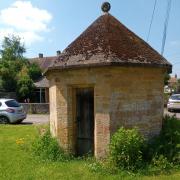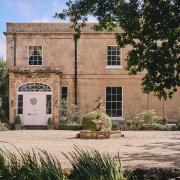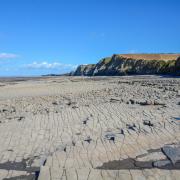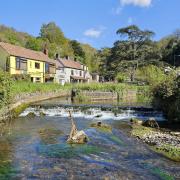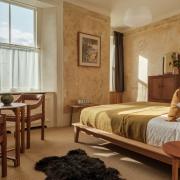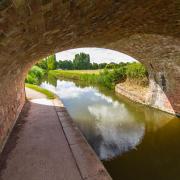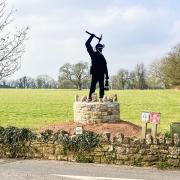‘And it was all yellow,’ so sang Chris Martin of Coldplay. He was referring to the colour of the stars and the love of his girl (presumably pre-Gwyneth) but he could have been talking of the Martock architecture, courtesy of the hamstone from nearby Ham Hill.
Not so obvious, and perhaps not so well-known, is that right now there is a mouse on the left hand side of the high altar, most likely hidden by a drape, in the village’s All Saints Church. The mouse is wooden, sculptured into the frame of the altar. Viewers of antique programmes will recognize it as the trademark signature of master furniture maker Robert (Mouseman) Thompson. The Rev Paul Fillery observed with delight that children love it. The church is in fact, after St Cuthbert’s in Wells, the second biggest parish church in the county.
Paul said: ‘I think there was money here in Martock and they were going to make sure that everybody knew it. There was a church in Norman times almost certainly, but there’s nothing that remains now so what you’ve got in the earliest part of the church is 13th and 14th century, there is evidence of that, bits of the walls and windows. The ceiling is about 800 years old and I think they found some shot in it from when Cromwell’s men were billeted in the church overnight in 1645.

‘The village is lovely, a really nice place, everyone says the people are friendly – everybody talks to each other, it’s got a very safe and welcoming feel to it. There is a genuine community here. The elderly folk are very well catered for and as far as social interaction and cohesion goes, it’s a good place.’
As well as the usual services, the church hosts concerts, from jazz to sea shanties, and just last month (April) held an exhibition featuring an oil painting, a textile sculpture and a poem, all extolling the beauties of creation.
The iconic Market House is home to the Parish Council (and also the public loos) but they also own the Parish Hall just down the road, which is full of daily activities. I met up with Joy Bailey who said she had lived in the village for 36 years but she was not a Martock Bean. To be a Martock Bean you have to be born and bred. That said, there is such a thing as a proper Martock Bean, a vegetable. She confessed she wasn’t very keen on them but said: ‘It has been revived when they thought it had gone extinct. It’s like a broad bean, more kind of chewy, it was used to thicken up potage, when they didn’t have the potato.’
Joy has been researching gravestones and the war memorial. There ought to be a word for this. Gravestonology? She pointed out the stone, barely legible, for one Queen Anstice who came to Martock from Barbados at the age of 16 and died two years later in 1680. Her latest subject is John U. Betty, who was brought up in a workhouse but got his life together with a wife and young daughter then died in the second year of the Great War.

Just opposite is The George, the village’s oldest inn but now a coffee shop/mother-and-toddler group/foodbank etc. We had a latte and Parish Councillor Joy explained the social contribution of the PC: ‘There are three in the community team, all part time. One of them does the job club; they help people put together CVs, interview techniques, inwork benefits. One of them looks after the more vulnerable members of the community; she does the foodbank liaison , Wednesday Club, community allotments, well-being walks. And the third one deals with the older people; lunch club on a Thursday, goes out and sees people who are referred to her, she gets the right agencies involved. It makes it a nicer place to live when we know that the older people aren’t sitting in their homes lonely and the more vulnerable members of the community have some support.’
For the young, there are scouts, guides, youth club, army cadets, boy’s brigade, several junior football teams, cricket, rugby and four tennis courts.
With all this, plus a mouse and a bean, Martock is pretty self-sufficient and…very yellow.
Woodworking plus
There’s been a woody presence in Martock for over 160 years now ever since Henry Yandle, wheelwright, moved to the village to set up shop. The wooden business has seen many shapes in that time, at the moment it is a woodworkers’ emporium providing machinery, hand-powered tools, accessories and of course the timber – but it’s also a hobby shop, an arts and craft, gift and home shop, a gallery and a café.
Curiously, for many years it’s speciality was making elm coffins. At the company’s peak, just after WWII, it had a hundred employees creating a thousand coffins a week and satisfying ten per cent of the country’s demand. Dutch elm disease saw the decline in that market.
Yandles and Sons (there are still descendants of Henry involved in the company) offers woodworking courses, two woodworking shows a year, a huge selection of hardwood and it’s own on-site saw mill. The craft store provides ceramic, textile and wood (of course) products that showcases the artistic work of west country craftsmen. The café has a tempting menu too.
Counting shop
The Grade I listed National Heritage property the Treasurer’s House is the oldest inhabited residency in Somerset with the exception of the Bishop’s Palace in Wells. First written of in 1221.
Open selected times in the summer.
POPULATION: 4,766 (2011)
STAY
In the neighbouring village of Bower Hinton, The Hollies Hotel is just a half mile from the A303. All ground floor rooms have patio doors leading to terraces with landscaped gardens. The restaurant has a modern European menu and there is a terrace for outside dining. The characterful cosy bar has oak beams and a fireplace. info@thehollieshotel.com






